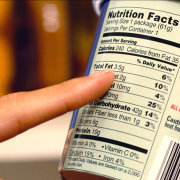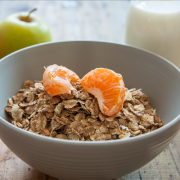
Carbohydrates are constantly at the centre of many heated debates in nutrition, creating much misunderstanding and uncertainty as to whether this food group should or shouldn’t be part of a healthy diet. The modern diet high in refined carbohydrates and simple sugars is of course not ideal for our health. But it is short-sighted to treat the vast range of foods containing carbohydrates as one all-inclusive food group as certain carbohydrates are better for our health than others.
The Good: High Fibre, Unprocessed Carbohydrates
There are great, proven health benefits that support that we should choose mostly high fibre, minimally processed carbohydrates as part of a healthy diet. Unprocessed carbohydrates include wholegrains and fruit. Wholegrains are grains which, after milling, naturally contain all the components of the original, unprocessed grain, such as the endosperm, bran, germ, and all the nutrients and fibre that come with it. The endosperm is the part of the grain that is the major nutritional contributor of wholegrains, with bioactive compounds such as fibres, phytochemicals, phenolic compounds and various micronutrients. Examples of wholegrains include wheat, spelt, brown rice, barley (not pearled), maize (corn), rye, oats, and sorghum.
There is strong support that most of our carbohydrate choices should be in the form of wholegrains rather than refined grains. The foundation of this support lies in the fibre content of wholegrains. In a large study on almost 400 000 participants, fibre from cereal grains decreased the risk of death from heart disease and cancer by 20%. In another study, three servings (45g) of wholegrain per day helped to reduce type 2 diabetes risk by 20%. This is why FitChef chooses to use wholegrains like wholewheat pasta, brown rice and oats in our meals.
Fruit is another example of an unprocessed carbohydrates. Fruits are rich in healthy nutrients like vitamins A and C, folate and potassium, contain gut-healthy fibre, are low in energy, and are virtually free from poor nutrients like cholesterol, sugar, sodium and saturated fat. This is why a diet that includes fruit can help manage our weight, lower blood pressure, reduce the risk of heart disease, stroke and some cancers, and improve gut health. In fact, low fruit intake has been linked to over 520 000 heart disease deaths and more than 1.2 million stroke deaths globally each year. Aim for 2 – 3 fit-sized servings of fruit per day.
The Bad: Refined, Processed Carbohydrates
Refined carbohydrates are produced by a series of mechanised processes called hulling and milling. The bran, germ, and endosperm of grains, the parts that provide great nutritional value, are removed in these processes making refined carbohydrates lower in nutrients and fibre, and therefore less healthy. Refined carbohydrates include white rice and foods made from white flour like white bread, white pasta, white wraps, cakes, and refined breakfast cereals like puffed rice and corn flakes. Compared to wholewheat flour, after refining refined wheat flour lost 83% of total phenolics, 79% of total flavonoids, 93% of ferulic acid, 78% of zeaxanthin, and 51% of lutein. Thus, products made from refined (white) flour are much lower in nutrients, as well as fibre. Reading food labels is a great tool to help improve your nutrient and fibre intake. Always choose the carbohydrate product with the most fibre. According to South African food label guidelines, for a product to be considered “high in fibre” it needs to contain more than 6g of fibre per 100g of the product. To be labelled as a “source of fibre”, the product needs to contain at least 3g of fibre per 100g.
The Ugly: Sugar
Sugar is part of the carbohydrate food group with very little nutritional value and a lot of energy, which is why we cannot compare sugar to the good carbohydrates like nutrient-packed wholegrains and fruit. Excess amounts of sugar, and sugar containing foods and drinks, are certainly not ideal for our health. These foods cause a quick spike in blood glucose, triggering a host of metabolic changes in the body like kickstarting the inflammatory processes that cause chronic disease, and impacting heart disease, diabetes, and overall health. Sugar doesn’t have much impact on our feeling of fullness yet is high in energy, possibly contributing to weight gain, too.
Unfortunately, even if you don’t actually add sugar to your diet, many food products are loaded with hidden sugar to help make them taste better. Learning to read food labels is a vital skill in the quest to watch your sugar intake. Other than sugar, common names to look out for on food labels include sucrose, fructose (high fructose corn syrup/ corn syrup), glucose, maltose, dextrose, honey, and molasses. The focus should be on minimally processed carbohydrates in the diet while keeping sugar and sugary treats for special occasions only. FitChef meals are proudly made of real foods and free from added sugar, apart from small amounts of honey occasionally.
It is clear that not all carbohydrates are created equal. Treating the expanse of foods containing carbohydrates as one all-inclusive food group is short-sighted. There are carbohydrate-containing foods that are not as healthy as other highly nutritious versions. Our focus should be on less (if any) refined and sugary carbohydrates and more on high fibre, unprocessed carbohydrates.
- Chanson-Rolle, A., Meynier, A., Aubin, F., Lappi, J., Poutanen, K., Vinoy, S., et al. (2015) Systematic Review and Meta-Analysis of Human Studies to Support a Quantitative Recommendation for Whole Grain Intake in Relation to Type 2 Diabetes. PLoS ONE ,10(6): e0131377. doi:10.1371/journal.pone.013137.
- Government Gazette. R429 Foodstuffs, Cosmetics and Disinfectants Act, 1972 (Act 54 Of 1972). Regulations Relating to the Labelling and Advertising of Foodstuffs. Department of Health, 2014.
- Jebb SA. Conference on “Carbohydrates in health: friends or foes’ Symposium 2: New perspectives on carbohydrates and health. Proceedings of the Nutrition Society. 2015;74:215-220.
- Katz DL and Meller S. Can we say which diet is best for health? Annual review of public health, 2014; 35: 83-103.
- Miller V et al. Estimated global, regional, and national cardiovascular disease burdens related to fruit and vegetable consumption: an analysis from the Global Dietary Database. Current Developments in Nutrition. 2019;3(S1). Available from: https://doi.org/10.1093/cdn/nzz028.FS01-01-19.
- Park, Y., Subar, A.F., Hollenbeck A, and Schatzin, A. (2011) Dietary fibre intake and mortality in the NIH-AARP Diet and Health Study. Arch Intern Med, 171(12): pp. 1061–1068.
- Position of the Academy of Nutrition and Dietetics: Health implications of dietary fiber. Journal of the Academy of Nutrition and Dietetics. 2015;115:1861-1870.
- Scientific Advisory Committee on Nutrition. Carbohydrates and Health. 2015. Public Health, London.

 No added or artificial sugars
No added or artificial sugars The cleanest ingredient labels
The cleanest ingredient labels






